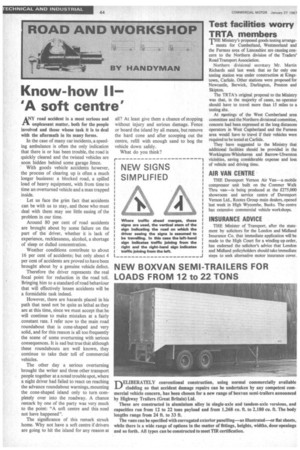I ROAD AND WORKSHOP
Page 46

If you've noticed an error in this article please click here to report it so we can fix it.
....1BY HANDYMAN Know-how II—
'A soft centre'
NY road accident is a most serious and unpleasant matter, both for the people Involved and those whose task it is to deal with the aftermath in its many forms.
In the case of many car incidents, a speeding ambulance is often the only indication that there is or has been trouble, the road is quickly cleared and the twisted vehicles are soon hidden behind some garage fence.
With goods vehicle accidents however, the process of clearing up is often a much longer business: a blocked road, a spilled load of heavy equipment, with from time to time an overturned vehicle and a man trapped inside.
Let us face the grim fact that accidents can be with us to stay, and those who must deal with them may see little easing of the problem in our time.
Around 80 per cent of road accidents are brought about by some failure on the part of the driver, whether it is lack of experience, recklessness, alcohol, a shortage of sleep or dulled concentration.
Weather conditions contribute to about 16 per cent of accidents; but only about 4 per cent of accidents are proved to have been brought about by a genuine vehicle defect.
Therefore the driver represents the real focal point for reduction in the road toll. Bringing him to a standard of road behaviour that will effectively lessen accidents will be a formidable task indeed.
However, there are hazards placed in his path that need not be quite as lethal as they are at this time, since we must accept that he will continue to make mistakes at a fairly constant rate. 1 refer now to the main road roundabout that is cone-shaped and very solid, and for this reason is all too frequently the scene of some overturning with serious consequences. It is sad but true that although these roundabouts are well known, they continue to take their toll of commercial vehicles.
The other day a serious overturning brought the writer and three other transport people together at a noted trouble spot, where a night driver had failed to react on reaching the advance roundabout warnings, mounting the cone-shaped island only to turn completely over into the roadway. A chance remark by one of the party was very much to the point: "A soft centre and this need not have happened".
The significance of this remark struck home. Why not have a soft centre if drivers are going to hit the island for any reason at all? At least give them a chance of stopping without injury and serious damage. Fence or board the island by all means, but remove the hard cone and after scooping out the centre, refill with enough sand to bog the vehicle down safely.
What do you think?












































































































